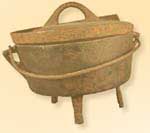THIS N THAT AND THE OTHER

If the text is to small to read,ajust your font button on your browser




Page two
Desperado
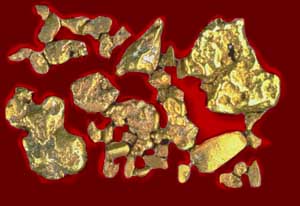
From around the world they came to search for gold

This page continues the era of the madd search for gold.
from page one

This photo is enlarged to show detail. What looks like rocks beside the nugget are infact grains of sand rounded by tumbling along the bottom by moving water.
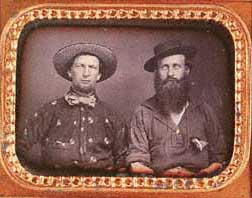
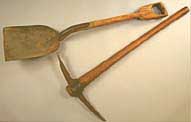
Thousands of people headed quickly to Feather River area of California thus creating instant cities and these spread to the YosemiteValley 
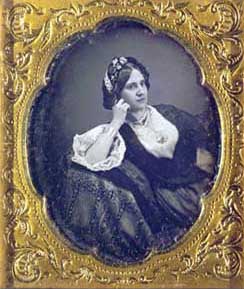
Not all of the sea of humanity going to California were men, women by the thousands journeyed overland with husbands and fathers and even some by themselves. The real number of women will never be known but at Fort Kearny the register offers hard data of 7,021 women and 8,270 children. Almost all the trail diaries mention women being among the wagon trains. Undoubtedly a few made reluctant companions most had the eagerness of going and getting rich and making their hard lives easier.
In a letter that never got delivered Catherine Haun and her husband frank wrote to friends that they longed to go to the new EL Dorado and pick up gold enough with which to return to Clinton Iowa and pay off all of their debts
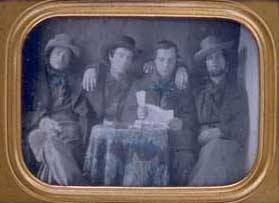
A MRS. Margaret Frank noted in her book that seeing the long trains of white -topped wagons for many miles that she had never seen so many people in all her life, and that if one tenth of the wagons got to California before her and her husband that there wouldn't be nothing left to pick up. The scenery through which we are passing is wild and magnificent and each new day is anticipated

All the days didn't bring good, many families lost loved ones, the sick that had somehow came down with cholera, the very young and the old were buried along the rutted trail. One wagon coming down a steep hill and a woman attempted to jump with a child in her arms her dress got caught in the wheel and both were crushed to death.The penultimate barrier between the immigrants and the gold was the 40 miles of desert and even the threat of death couldn't stop this GOLD FEVER. The guidebooks all said that the desert crossing had to be in one stretch as there is no grass for the ox or horse and mule and no water fit to drink

The most frightening of events in the gold rush diaries was the desert crossing. The trains had already traveled more then 18,00 miles and their oxen, mules, and horses were worn and their spirits and bodies fatigued. The people were also tired and near starvation level and game was scarce. Mrs. Luzenda Wilson said in her book that it was a forced march lasting three days over alkali flats and we carried with us the water for both men and animals, till we reached the other side. The ground was so hot it scorched our feet and the grayish dust hung around us like a cloud with no wind to blow it away. The dust made our eyes red and tongues parched. The trail was lined with skeletons of the poor beast who had died in the struggle.

In 1849 one Sally Hester wrote in her diary, Had a trying time crossing the desert and lost several of our cattle because of no water or grass. The crossing started on Monday at three in the afternoon and we reached the otherside Thursday morning at sunrise The Royce family crossed a month after the Hesters and traveled at night to avoid the heat but in the dark they missed the fork to the meadow the guidebook said was essential for cutting grass for the crossing.They were far into the desert when they realized their mistake. For many weeks we had been accustomed to see property abandoned and animals dead or dying. But in the desert that scene was doubled Horses, oxen, and mules suffering from heat, thirst and starvation, staggered along until they fell and died on every rod of the trail.Both sides of the trail were lined with dead animals, and abandoned wagons. Around them were stewed yokes, chains,harness, guns,tools,bedding clothing, cooking-utensils and many other items in utter confusion. The owners had left everything and hurried on to save themselfs. No one stopped to gaze or help as the situation was so desperate that, in most cases , no one could help another for each had all they could do to save themselfs. In 1849 more then 7,000 of these gold hunters headed north in hope of an easier crossing near the Oregon border, they only traded the 40 mile derert for the Black Rock desert and added 200 mile on their journey.

Most of the immigrants going to California had no choice but to get there by sea. Their journey was long, hard and very dangerous. Preparing one's self for a four to eight month journey was easy by the ships' advertisments of getting rich in California, The land of milk and honey where gold is easy to find. That promise was quickly replaced with sea sickness and the realities of life on a ship that rolled and pitched in the water that never was calm. In diaries and letters these gold seekers recored terrible storms, inadeqate food and water, rampant diseases, overcrowding, and shipwrecks. Between April 1849 and January 1850 nearly 40,000 gold seekers arrived in San Francisco by ship. They discovered that they were more then 200 miles from the closest gold fields and that most of the easy placer gold had already been picked up.
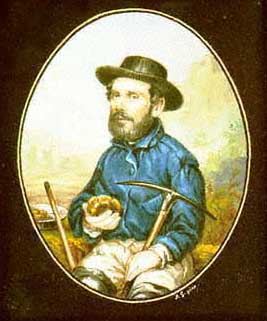 Very few of the men that came from around the world in search of this yellow rock had the slightest idea how to find it. Mineing was hard and tedious work. Prospecting was a insufferable grind of rigorous walking and grueling geological sampling made even more frustrating by the lack of testing equipment. Very few of the men that came from around the world in search of this yellow rock had the slightest idea how to find it. Mineing was hard and tedious work. Prospecting was a insufferable grind of rigorous walking and grueling geological sampling made even more frustrating by the lack of testing equipment. |
|
Not all who came to California spent their time mining. Not all that got rich found their gold at the edge of a river or stream. Many failed miners became business entrepreneurs. 275,000 gold seekers came to California and they all needed food and housing, transportation and banking services, mining equipment and clothing and just about everything else. There was an enormous amounts of gold to be spent and if you had what these miners needed they would buy it.
The voracious appetites of the miners created a cattle boom which sustained the southern California ranching economy for nearly a decade. As the cattle industry declined, Irrigation systems opened newly acquired lands to cultivation and that blossomed with grains, vegetables, and fruits of all kind. The lone miner was a thing of the past as groups of men put their heads together and formed large companys and modern mining equipment that could process large amounts of earth and useing water to wash the gold from it's hideing below ground level.
Californias gold machines were the best in the world but wrecked havoc on the environment. Massive floating barges scooped up millions of tons of river gravels, hard rock miners blasted and tunneled their way into the mountains and blew apart the hills and washed them into the river and streams Tons of mercury used to extract the gold escaped into the rivers and entered the food chain. Nature didn't stand a chance.

California wasn't the only part of the country where gold was found,
OREGON, IDAHO, UTAH,and NEVADA and COLORADO
also found gold.
Buttons and Bars by Cowgirl Bo
Check back for updates.


For your visit to Gold Fever
If you liked this page be sure to visit THE PAST page.
Please be sure to Sign my GuestBook and feel free
to View what others have had to say.
GuestBook







